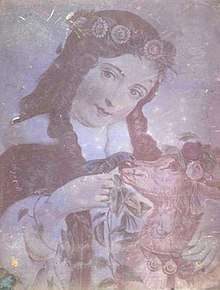Heliochrome
A heliochrome is a color photograph, particularly one made by the early experimental processes of the middle 19th to early 20th centuries. The word was coined from the Greek roots "helios", the sun, and "chroma", color, to mean "colored by the sun". It was applied to images as technologically diverse as Levi Hill's "Hillotypes" of the 1850s (Hill's instruction book was entitled A Treatise on Heliochromy)[1], the three-color carbon prints made by Louis Ducos du Hauron in the 1870s[2], and the interference color photographs made by Gabriel Lippmann in the 1890s[3]. It was also occasionally misapplied to images whose color was non-photographic, i.e., due to local coloring by handwork of some kind.

A circa 1850 "Hillotype" photograph of a colored engraving. Long believed to be a complete fraud, recent testing found that Levi Hill's process did reproduce some color photographically, but also that many specimens had been "sweetened" by the addition of hand-applied colors.
References
- Hill, Levi L. (1856). A treatise on heliochromy : or, The production of pictures, by means of light, in natural colors. Embracing a full, plain, and unreserved description of the process known as the hillotype, including the author's newly discovered collodio-chrome, or natural colors on collodionized glass ... Getty Research Institute. New York : Robinson & Caswell.
- Ducos du Hauron, Alcide (1898). La photographie des couleurs : et les decouvertes de Louis Ducos du Hauron. Getty Research Institute. Paris : A.L. Guyot.
- Lippmann, G. (1896-01-01). On Colour Photography by the Interferential Method. Royal Society of London.
This article is issued from Wikipedia. The text is licensed under Creative Commons - Attribution - Sharealike. Additional terms may apply for the media files.